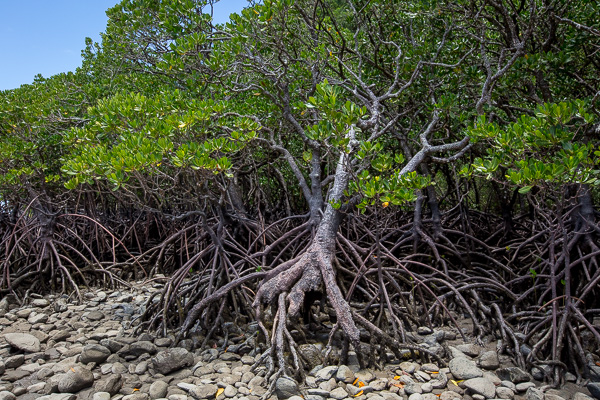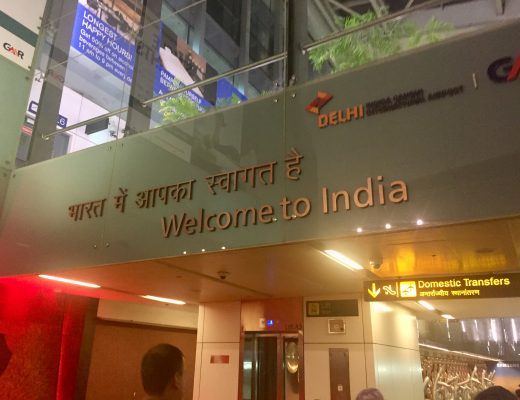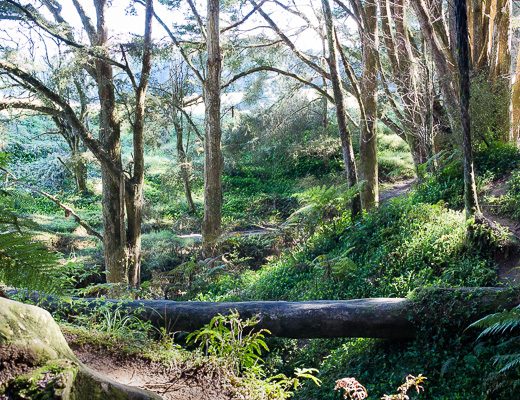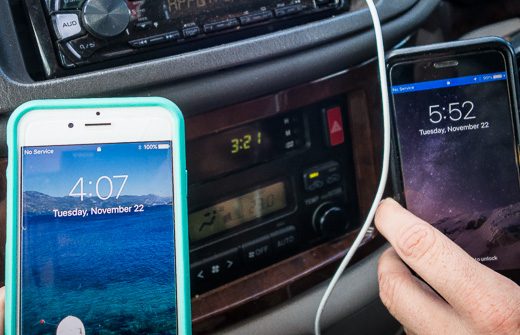When most people think of Australia, their minds tend to focus on either key architectural details found in the country’s packed cities (Sydney Harbor Bridge and Opera House, etc.), the Great Barrier Reef, or the dry, wide open, empty spaces found in the interior.
However, there is another interesting area worth considering – the ancient Daintree Rainforest and beautiful Cape Tribulation. The location where Captain Cook nearly met his match with the Great Barrier Reef. A place where the conifers and ferns of today differ little with those found in the same spot 100 to 180 million years ago. An area where crocodiles and cassowaries still roam, much like they did hundreds of thousands of years ago.
This past weekend, Sarah and I did a wonderful two day tour through the Daintree Rainforest and loved every minute of it. We were picked up our our Airbnb in Cairns and took our time making the two-and-a-half-hour drive north into the rainforest. The road speeds quickly out of the city and then slows as it edges between lush, green, tree-covered ridges to the left and too-blue ocean on the right. The only area in the world where two world heritage sites meet, the Daintree Rainforest and the Great Barrier Reef.
Most of the landmarks in this area carry rather foreboding names such as The Mountain of Sorrow, and Cape Tribulation amongst others. While to my untrained eye it looked no more than melancholy, we learned the names were actually given by Lt. James Cook and crew after being stranded on the Great Barrier Reef in 1770. The vessel was so badly damaged that it seemed death was the only escape, thereby marring their sentiments of the area.
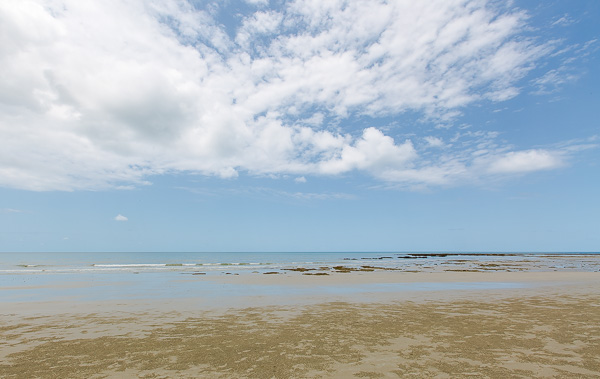
Cape Tribulation doesn’t seem very terrible to us!
The drive continues past the pretty, tourist town of Port Douglas until reaching the Daintree River, to be crossed only via ferry. While it may be a minor inconvenience, the need for a ferry and the lack of road access has probably been a key factor in preserving the area’s untouched feel.
After a few more kilometers, the forest really begins to take over with trees almost encapsulating the road. Our guide reminded us to keep our eyes open and just as he finished speaking, an adult cassowary jumped out in front of the bus and started eating by the side of the road. It was like a scene out of the movie Jurassic Park. I’ve never before seen an animal that looked so out of place in today’s world.

Unfortunately the cassowaries that we saw were all quite fast moving and so our pictures are blurs. Thank goodness for the Australian Zoo.
When the cassowary got its fill of being photographed, we pushed on for another 20 minutes until reaching the start of a forest walk. Although the track was only a little over one kilometer, it took us nearly a full hour to complete the loop as we stopped frequently to learn about some of the plants and animals we were seeing. These ranged from climbing vines that had wicked looking hooks to help crawl upwards to a golden-backed spider that eats her mate(s) and a bright purple cassowary plum which seems unnatural in a forest full of green. Most importantly, we learned where rattan comes from (and already know where all of it ends up – at my mother-in-laws cabin).
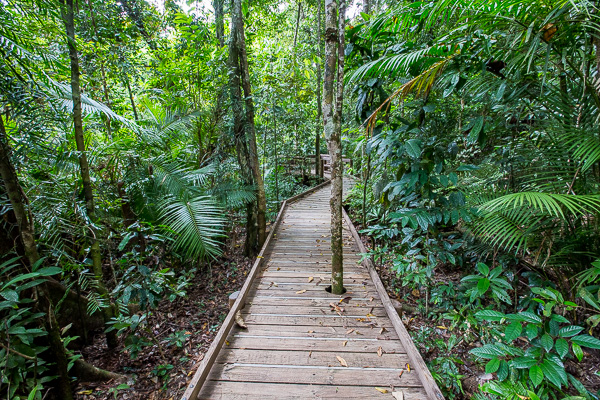
The path we walked through the Daintree Rainforest.
Shortly afterwards our hike was finished, we arrived at our bungalow and couldn’t have been more thrilled. It was built right into the jungle and around the corner from a beautiful beach. Given it is Australia, where basically everything is trying to kill you, we weren’t able to take full advantage of the beach as there was a four meter croc prowling around the area and we didn’t want to get eaten. Even with that minor setback, the setting was just gorgeous and we were kicking ourselves for not booking a second night.
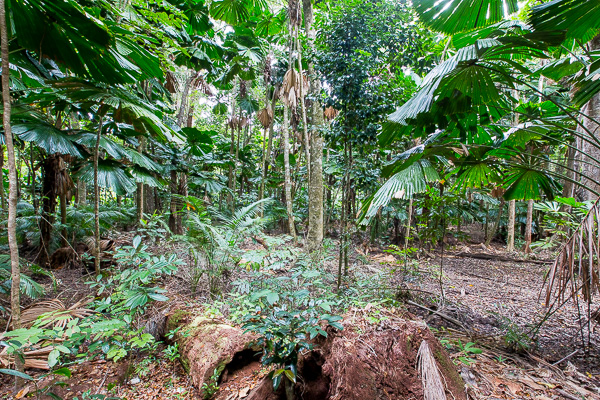
The view from our porch at Cape Tribulation Beach House.
The following day, we had a noon pickup and were driven further on down the beach we’d stayed at. Moving just one kilometer away totally changed the scenery from coastal coral and dense jungle to mangrove trees.
We picked up the rest of the group at the beach and were treated to a quick stop at a local ice cream shop famous for making their treats out of local fruits. Sarah enjoyed a cup with four flavors including Yellow Sapote, Jackfruit, Davidson Plum, and Wattle Seed. I think you could recreate the flavor sensations by mixing sugar with glue and freezing them for a couple hours.
We hopped back on the road to make our way back to the Daintree River for an hour-long crocodile cruise to try and spot one of Australia’s most infamous animals. We were fortunate enough to spot a few of them, but didn’t come across as many was we were hoping to see. As the weather starts to warm up, the crocodiles need to spend less and less time out of the water so there are fewer chances to see them.
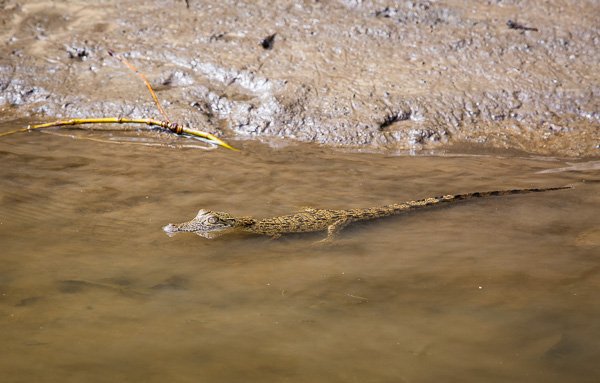
One of the baby crocodiles that we saw on our boat tour.
Following our croc spotting adventure, we ended the tour with a trip to Mossman Gorge for a quick dip in the clear and refreshing waters. The gorge is an important aboriginal site with a wonderful walking path that runs along the picturesque, boulder-strewn river.
Overall, we had a great time on our tour of the Daintree Rainforest with the caveat being that we wished we had spent more time!
